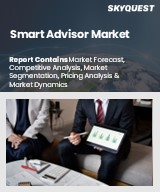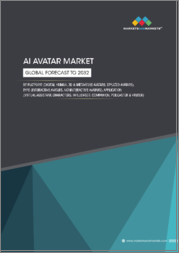
|
시장보고서
상품코드
1796127
스마트 어드바이저 시장 규모, 점유율, 성장 분석 : 배포 방식별, 기술별, 용도별, 최종 용도별, 지역별 - 산업 예측(2025-2032년)Smart Advisor Market Size, Share, and Growth Analysis, By Deployment (Cloud-Based, On-Premises), By Technology (Artificial Intelligence, Machine Learning), By Application, By End Use, By Region - Industry Forecast 2025-2032 |
||||||
세계의 스마트 어드바이저 시장 규모는 2023년에 79억 달러로 평가되며, 2024년 87억 8,000만 달러에서 2032년에는 203억 7,000만 달러로 성장하며, 예측 기간(2025-2032년)의 CAGR은 11.1%로 성장할 전망입니다.
자동화, 개인화, 실시간 의사결정 지원에 대한 수요가 증가하면서 스마트 어드바이저의 혁신적 상황은 빠르게 진화하고 있습니다. 은행, 의료, E-Commerce, IT 서비스 등 다양한 분야의 조직들이 머신러닝과 자연 언어 처리를 통합한 AI 기반 자문 플랫폼을 활용하여 반응성과 상황 인식을 강화하고 있습니다. 이러한 성장은 업무량과 의사결정 시간을 줄이고, 고객 경험과 업무 효율성을 크게 향상시킬 수 있습니다. 스마트 어드바이저는 현재 디지털 전환 전략의 핵심으로, 복잡한 데이터에 기반한 실시간 의사결정을 가능하게 하고, 개인화에 대한 기대가 높아지는 상황에서 스마트 어드바이저는 그 역할을 하고 있습니다. 또한 이러한 솔루션은 인력 문제, 기술 격차, 고객 대응의 불일치를 해결하고, 확장 가능한 24시간 서비스 제공을 가능하게 합니다. 이 시장은 통합형 스마트 어드바이저의 진화를 보여주며, 다국어 지원과 클라우드 기반 기능을 강화하여 세계 서비스를 강화할 것으로 예측됩니다.
목차
서론
- 분석 목적
- 시장 범위
- 정의
분석 방법
- 정보 조달
- 2차·1차 데이터 방법
- 시장 규모 예측
- 시장 상정과 제약
개요
- 시장 개요와 전망
- 수급 동향 분석
- 부문별 기회 분석
시장 역학과 전망
- 시장 개요
- 시장 규모
- 시장 역학
- 촉진요인과 기회
- 억제요인과 과제
- Porter의 산업 분석
시장의 주요 인사이트
- 주요 성공 요인
- 경쟁의 정도
- 주요 투자 기회
- 시장 에코시스템
- 시장의 매력 지수(2024년)
- PESTEL 분석
- 거시경제 지표
- 밸류체인 분석
- 가격 분석
- 사례 연구
세계의 스마트 어드바이저 시장 규모·CAGR : 배포 방식별(2025-2032년)
- 시장 개요
- 클라우드 기반
- 온프레미스
- 하이브리드
세계의 스마트 어드바이저 시장 규모·CAGR : 기술별(2025-2032년)
- 시장 개요
- 인공지능
- 기계학습
- 자연언어처리
세계의 스마트 어드바이저 시장 규모·CAGR : 용도별(2025-2032년)
- 시장 개요
- 재무 어드바이저리
- 법무 어드바이저리
- 의료 어드바이저리
- 마케팅 어드바이저리
세계의 스마트 어드바이저 시장 규모·CAGR : 최종 용도별(2025-2032년)
- 시장 개요
- 중소기업
- 대기업
- 개인 사용자
세계의 스마트 어드바이저 시장 규모·CAGR(2025-2032년)
- 북미
- 미국
- 캐나다
- 유럽
- 독일
- 스페인
- 프랑스
- 영국
- 이탈리아
- 기타 유럽
- 아시아태평양
- 중국
- 인도
- 일본
- 한국
- 기타 아시아태평양
- 라틴아메리카
- 브라질
- 기타 라틴아메리카
- 중동 및 아프리카
- GCC 국가
- 남아프리카공화국
- 기타 중동 및 아프리카
경쟁 구도
- 상위 5사의 비교
- 주요 기업의 시장 포지셔닝(2024년)
- 주요 기업이 채택한 전략
- 시장의 최근 동향
- 주요 기업의 시장 점유율(2024년)
- 주요 기업의 개요
- 기업 개요
- 제품 포트폴리오 분석
- 부문별 점유율 분석
- 매출의 전년대비 비교(2022-2024년)
주요 기업 개요
- IBM
- Oracle
- Salesforce
- Deloitte
- Microsoft
- PwC
- Cognizant
- HCL Technologies
- Capgemini
- AntWork
- Tata Consultancy Services
- SAP
- Accenture
- Infosys
결론과 제안
KSA 25.08.29Global Smart Advisor Market size was valued at USD 7.9 billion in 2023 and is poised to grow from USD 8.78 billion in 2024 to USD 20.37 billion by 2032, growing at a CAGR of 11.1% during the forecast period (2025-2032).
The innovation landscape for smart advisors is rapidly evolving, driven by increasing automation, personalization, and real-time decision support demands. Organizations across various sectors, including banking, healthcare, e-commerce, and IT services, are leveraging AI-driven advisory platforms that integrate machine learning and natural language processing to enhance responsiveness and context-awareness. This growth reduces workloads and decision-making times, significantly improving customer experience and operational efficiency. Smart advisors are now central to digital transformation strategies, enabling complex, data-backed decisions in real-time to meet rising personalization expectations. Additionally, these solutions address workforce challenges, skill gaps, and inconsistencies in customer interactions, providing scalable, round-the-clock service delivery. The market is anticipated to witness an evolution of integrated smart advisors, enhancing multilingual support and cloud-based capabilities to bolster global service.
Top-down and bottom-up approaches were used to estimate and validate the size of the Global Smart Advisor market and to estimate the size of various other dependent submarkets. The research methodology used to estimate the market size includes the following details: The key players in the market were identified through secondary research, and their market shares in the respective regions were determined through primary and secondary research. This entire procedure includes the study of the annual and financial reports of the top market players and extensive interviews for key insights from industry leaders such as CEOs, VPs, directors, and marketing executives. All percentage shares split, and breakdowns were determined using secondary sources and verified through Primary sources. All possible parameters that affect the markets covered in this research study have been accounted for, viewed in extensive detail, verified through primary research, and analyzed to get the final quantitative and qualitative data.
Global Smart Advisor Market Segments Analysis
Global Smart Advisor Market is segmented by Deployment, Technology, Application, End Use and region. Based on Deployment, the market is segmented into Cloud-Based, On-Premises and Hybrid. Based on Technology, the market is segmented into Artificial Intelligence, Machine Learning and Natural Language Processing. Based on Application, the market is segmented into Financial Advisory, Legal Advisory, Healthcare Advisory and Marketing Advisory. Based on End Use, the market is segmented into Small and Medium Enterprises, Large Enterprises and Individual Users. Based on region, the market is segmented into North America, Europe, Asia Pacific, Latin America and Middle East & Africa.
Driver of the Global Smart Advisor Market
With the evolution of consumer expectations, businesses across various sectors are compelled to respond to the increasing demand for faster, tailored support and services. Smart advisors, leveraging AI and natural language processing, serve as advanced conversational interfaces that facilitate real-time interactions enriched with contextually relevant knowledge. This not only enhances user experience but also boosts customer satisfaction. In industries such as banking, healthcare, and retail, these intelligent systems reduce wait times, improve service delivery, and foster brand loyalty. Consequently, the capability to offer round-the-clock, intelligent assistance is rapidly transitioning from a desirable feature to a fundamental competitive necessity.
Restraints in the Global Smart Advisor Market
The Global Smart Advisor market faces significant challenges related to data privacy and regulatory compliance, which pose formidable obstacles to growth. Concerns about data security, user consent, and the ethical handling of personal information are paramount, especially within highly regulated industries such as banking and healthcare. The complexities of navigating diverse regulations, including GDPR in Europe and HIPAA in the U.S., can lead to delays in the deployment of smart advisor technologies. These regulatory hurdles often result in limited functionalities, thus hindering adoption by organizations that prioritize risk management and are reluctant to embrace solutions that may expose them to compliance violations.
Market Trends of the Global Smart Advisor Market
The Global Smart Advisor market is experiencing a significant transformation as organizations increasingly adopt generative AI technologies to enhance user interactions. This shift emphasizes a departure from traditional rule-based systems toward advanced conversational AI that offers hyper-personalized experiences. By leveraging sophisticated models like GPT and other large language models, smart advisors are evolving to deliver tailored recommendations, engage in fluid dialogue, and learn from user behavior in real time. This trend is particularly impactful across sectors such as banking, e-commerce, healthcare, and SaaS, where intuitive user interfaces can improve customer experience. The ultimate goal is to transcend basic scripted responses by developing true digital assistants that embody a more human-like interaction.
Table of Contents
Introduction
- Objectives of the Study
- Scope of the Report
- Definitions
Research Methodology
- Information Procurement
- Secondary & Primary Data Methods
- Market Size Estimation
- Market Assumptions & Limitations
Executive Summary
- Global Market Outlook
- Supply & Demand Trend Analysis
- Segmental Opportunity Analysis
Market Dynamics & Outlook
- Market Overview
- Market Size
- Market Dynamics
- Drivers & Opportunities
- Restraints & Challenges
- Porters Analysis
- Competitive rivalry
- Threat of substitute
- Bargaining power of buyers
- Threat of new entrants
- Bargaining power of suppliers
Key Market Insights
- Key Success Factors
- Degree of Competition
- Top Investment Pockets
- Market Ecosystem
- Market Attractiveness Index, 2024
- PESTEL Analysis
- Macro-Economic Indicators
- Value Chain Analysis
- Pricing Analysis
- Case Studies
Global Smart Advisor Market Size by Deployment & CAGR (2025-2032)
- Market Overview
- Cloud-Based
- On-Premises
- Hybrid
Global Smart Advisor Market Size by Technology & CAGR (2025-2032)
- Market Overview
- Artificial Intelligence
- Machine Learning
- Natural Language Processing
Global Smart Advisor Market Size by Application & CAGR (2025-2032)
- Market Overview
- Financial Advisory
- Legal Advisory
- Healthcare Advisory
- Marketing Advisory
Global Smart Advisor Market Size by End Use & CAGR (2025-2032)
- Market Overview
- Small and Medium Enterprises
- Large Enterprises
- Individual Users
Global Smart Advisor Market Size & CAGR (2025-2032)
- North America (Deployment, Technology, Application, End Use)
- US
- Canada
- Europe (Deployment, Technology, Application, End Use)
- Germany
- Spain
- France
- UK
- Italy
- Rest of Europe
- Asia Pacific (Deployment, Technology, Application, End Use)
- China
- India
- Japan
- South Korea
- Rest of Asia-Pacific
- Latin America (Deployment, Technology, Application, End Use)
- Brazil
- Rest of Latin America
- Middle East & Africa (Deployment, Technology, Application, End Use)
- GCC Countries
- South Africa
- Rest of Middle East & Africa
Competitive Intelligence
- Top 5 Player Comparison
- Market Positioning of Key Players, 2024
- Strategies Adopted by Key Market Players
- Recent Developments in the Market
- Company Market Share Analysis, 2024
- Company Profiles of All Key Players
- Company Details
- Product Portfolio Analysis
- Company's Segmental Share Analysis
- Revenue Y-O-Y Comparison (2022-2024)
Key Company Profiles
- IBM
- Company Overview
- Business Segment Overview
- Financial Updates
- Key Developments
- Oracle
- Company Overview
- Business Segment Overview
- Financial Updates
- Key Developments
- Salesforce
- Company Overview
- Business Segment Overview
- Financial Updates
- Key Developments
- Deloitte
- Company Overview
- Business Segment Overview
- Financial Updates
- Key Developments
- Microsoft
- Company Overview
- Business Segment Overview
- Financial Updates
- Key Developments
- PwC
- Company Overview
- Business Segment Overview
- Financial Updates
- Key Developments
- Cognizant
- Company Overview
- Business Segment Overview
- Financial Updates
- Key Developments
- HCL Technologies
- Company Overview
- Business Segment Overview
- Financial Updates
- Key Developments
- Capgemini
- Company Overview
- Business Segment Overview
- Financial Updates
- Key Developments
- AntWork
- Company Overview
- Business Segment Overview
- Financial Updates
- Key Developments
- Tata Consultancy Services
- Company Overview
- Business Segment Overview
- Financial Updates
- Key Developments
- SAP
- Company Overview
- Business Segment Overview
- Financial Updates
- Key Developments
- Accenture
- Company Overview
- Business Segment Overview
- Financial Updates
- Key Developments
- Infosys
- Company Overview
- Business Segment Overview
- Financial Updates
- Key Developments



















